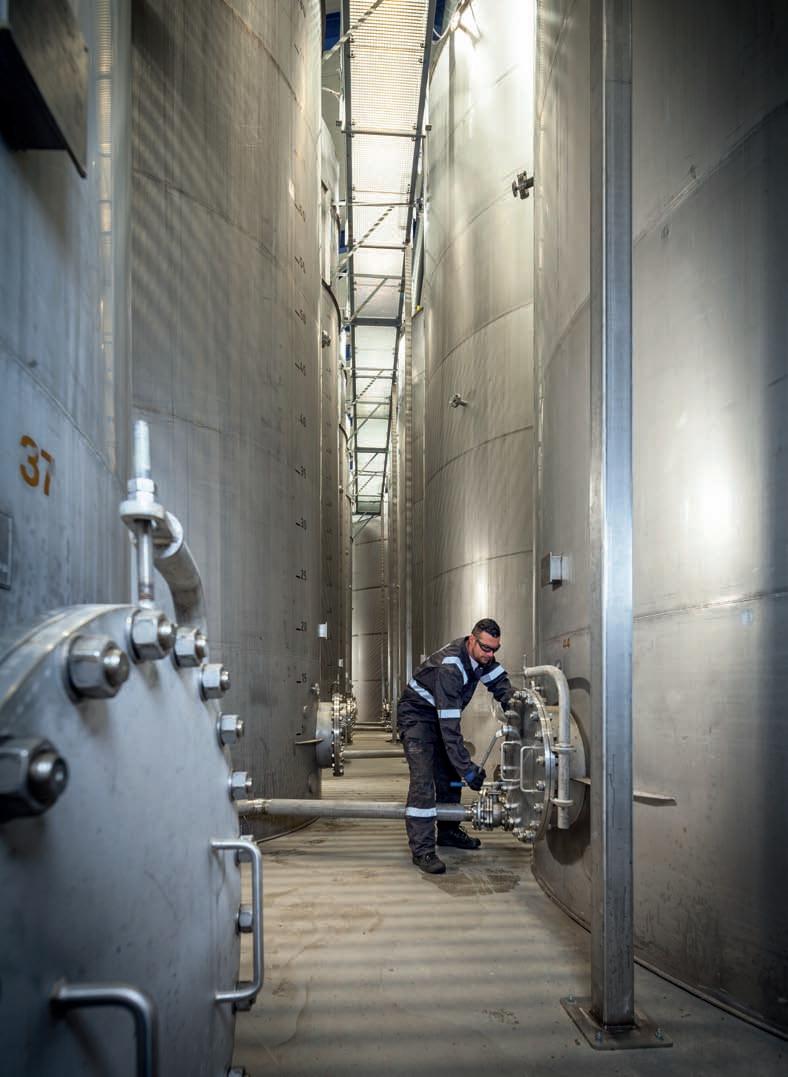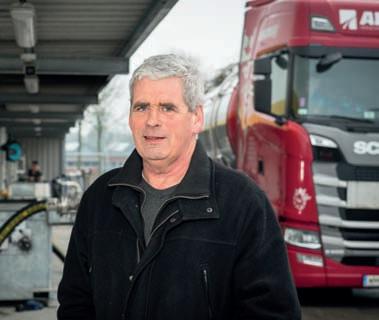
9 minute read
Europe’s largest natural latex tank
Europe’s largest natural latex tank terminal





Kelvin Terminals doubles storage capacity and eliminates dependence on fossil fuels
SiNcE ThE ExPaNSioN WiTh TWELvE STaiNLESS STEEL TaNKS ThE comPaNy haS a ToTaL SToragE caPaciTy of 7,000T.
North Sea Port plays a leading role in many industrial and logistic segments. With Kelvin Terminals, the port is home of Europe’s largest storage facility for liquid latex. The company recently expanded its storage facilities. This expansion, together with the enlargement of the office and laboratory, shows the trust the terminal gets from its Singapore mother company.
Kelvin Terminals was established in Terneuzen in 1964 as a storage facility for oil products for Esso (ExxonMobil). In the early seventies, the company changed its scope towards the storage of synthetic rubber for the UK based International Synthetic Rubber Company (ISR). This company was looking for storage facilities in Europe, as until then it depended on the unreliable ferry services for the supply of products to Europe, and opted for Terneuzen. The company has since undergone some turbulent decades, with several changes in owners. Today, as a dedicated logistics service provider for natural rubber producer Corrie Maccoll (part of Halcyon Agri), Kelvin Terminals has reached a phase of stable development. Managing Director of Kelvin Terminals Pascal de Maat entered the company in 1987.
The Englishman “Since I joined the company, I have seen a lot of things happen. Back in the Eighties, the company was part of Italian multinational Eni. In those days, this eventually gave us ample work, but this changed due to various circumstances and it was suggested to sell our terminal. We became part of the Zaandam-based company Wurfbain in 2013. From that moment onwards, we started specialising in the storage and handling of natural rubber latex only.” Mr de Maat explains how this happened: “One day in 2012, an Englishman came to us looking for the possibility of renting some storage tanks for natural latex and when I told him that our terminal was for sale, it came to light that he was working for Wurfbain. This company was interested in a takeover, which became effective a year later.” One of Mr de Maat’s aims was to further expand and modernise the enterprise. “For our expansion plans, we had an option on a piece of land next to our terminal, as well as an option on a number of storage tanks available on the market. Wurfbain was hesitant to grant permission for the investment, but the opportunity to execute our plans arose in 2018 when Wurfbain and Kelvin became part of Singapore-based rubber company Halcyon Agri. When I explained my plans to their management, they soon agreed.”
High vulnerability The expansion of the storage facility started in September 2018 and was finalised in 2019. Meanwhile, the offices were refurbished and the old, small laboratory was replaced by a new modern one that now fully meets todays requirements. “This laboratory is of great importance for us,” Mr de Maat explains, “as the handling and storage of latex can be complicated due

Logo When looking at Kelvin Terminal’s logo, one will notice two birds. These birds are kingfishers. The birds refer to the name of mother company Halcyon Agri. Halcyon is a breed of kingfishers. The kingfisher in the past used to be considered as a symbol of unconditional loyalty, power, wealth, peace, and beauty. A fine symbol, that suits an involved company like Halcyon Agri.
from EvEry ShiPmENT KELviN TaKES a SamPLE for iNvESTigaTioN iN iTS LaboraTory. So ThE comPaNy KNoWS ThE ExacT quaLiTy of ThE iNcomiNg ProducTS.
to the high vulnerability of this natural product.” The Terneuzen laboratory is now number 3 in the world for testing in such detail the parameters of natural latex. Natural rubber is a product made from latex. Latex is tapped from rubber trees. Halcyon Agri buys the latex from independent farmers in Thailand, Malaysia, Guatemala, Vietnam, and Indonesia, and also owns plantations in Cameroon. A rubber tree needs to be seven years old before it starts producing latex and this production ends after approximately 25 years. Mr de Maat elaborates, “Each tree produces around 6kg of latex per year, so each tree produces approximately 150kg of rubber in its entire productive life. 30% of the latex tapped from the trees is rubber and after a process of centrifugation, 60% of rubber remains from each kilogramme of latex. This rubber, added with a certain amount of ammonia to protect the product from contamination, is stored for maturation for a period of four weeks. Only 10% of the total amount of rubber is liquid. The largest part is dry rubber, which is mainly used for the production of tyres. These figures demonstrate that liquid rubber truly is a small-scale specialty product.”
Impressive knowledge “In 1964,” Mr de Maat continues, “our terminal was founded in Terneuzen because of the strategic location towards the North Sea and the hinterland, and today this is still an important plus. Apart from this, we have built up an impressive knowledge and experience in the careful handling of natural rubber latex. Rubber latex is a very stressful product, meaning that the slightest change in circumstances can influence the quality. With our skills and equipment, we are able to handle and store the product in the most ideal conditions. From every shipment we receive, we take a sample for investigation in our laboratory. So we know the exact quality of the incoming products. We also use the sample for traceability purposes in case a customer has questions about their product. In the process of loading and unloading, all operations are executed manually. This might sound a bit old-fashioned, but automated systems

Photo courtesy of Kelvin Terminal.

LaTEx iS TaPPEd from rubbEr TrEES.
do not have the same sensitivity as human hands. A person can, for example, feel when the product is less fluid than it should be, and can swiftly respond to this. In an automated system, the pumping of the product would continue, no matter what.”
Dedicated storage “At our terminal we store natural rubber latex for our sister companies Wurfbain and Centrotrade (Eschborn), and a third party Synthomer (Marl). Since the expansion with twelve stainless steel tanks (2 of 500m 3 , 4 of 250m 3 , and 6 of 125m 3 ), the company has a total storage capacity of 7,000t. Around 50,000t is handled annually, including 25,000t that arrive from our sisters and Synthomer and the same amount that leaves to producers of a broad range of products, such as matrasses, pillows, surgical gloves, bitumen/asphalt, bay toys, catheters, cork shoes, selfadhesive bandages, balloons, condoms, and even chewing
gum. For these products, natural rubber latex is superior to the synthetic alternative made from oil.” The expansion of Kelvin’s storage capacity also fits within Halcyon Agri’s sustainability goals. At the rooftop of the new tank hall, 126 solar panels are installed that can provide 51,000kWh per year. For controlling the tank hall’s temperature, air source heat pumps are installed, replacing a diesel oil-fuelled boiler. “The solar panels and air source heat pumps will completely eliminate our dependence on fossil fuels”, claims Mr de Maat. Kelvin Terminals can at present be considered the largest storage facility for liquid rubber latex in Europe. “When comparing our total storage capacity with that of, for example, Oil Tanking Terneuzen, we are just a modest tank terminal,” argues Mr de Maat, “but looking at the total annual worldwide production of natural rubber, it makes more sense. Although rubber is considered a commodity, when looking at total volumes one can honestly say that we are operating in a niche market.” Apart from storing the rubber, Kelvin also has facilities for blending and mixing to meet specific customer requirements. “For most customers, the 125m 3 tanks are the perfect solution for storing their product, as one such tank equals the volume of one shipping batch. The larger tanks usually contain mixtures of shipments and varieties.”
CSR efforts With the recent investments, Kelvin Terminals is looking towards a bright future. Apart from doubling the storage capacity, high investments have furthermore been made in a larger office and new laboratory that now meets the highest requirements concerning health and safety. “It is good to see that Halcyon puts ample trust in our terminal and that the company has also supported our desire to invest in sustainability and safety”, voices Mr de Maat. He continuous, “Sustainability, safety, and health are important issues for Halcyon, and therefore the company in many ways puts abundant effort into CSR. The company is aware of the fact that rubber is a product of nature. It is hence important to act as sustainably as possible to protect this nature. It is relevant for the continuation of the company. With more than 20,000 people working in factories and plantations worldwide, Halcyon constantly works on good labour conditions. Investments are made in education, quality childcare, healthcare, as well as in infrastructure in and around the local communities in which the company operates.”
Local suppliers For the construction of the new facilities, Kelvin Terminal relied on local construction companies and for logistic support, the company also prefers to use nearby distributors like Verbrugge, 3MCT, Swagemakers, and Tieleman. Most of the rubber latex arrives at the terminal in 20ft containers. Each container has a PPE bag that can contain 23,000l of rubber. The containers are shipped to Terneuzen by truck, train or barge. For the transportation to customers, tank trucks, tank containers and IBC containers and drums are mostly used. “We have a
Most of the rubber latex arrives at the terMinal in 20ft containers. each container has a PPe bag that can contain 23,000l of rubber.

Managing Director of Kelvin terMinals Pascal De Maat: “since i joineD the coMPany, i have seen a lot of things haPPen.”

good partnership with our local logistic partners and they think along with us to find the right transport solution, whether this is by truck, barge or train. Whenever possible, we obviously prefer to use the most efficient and sustainable solution.” Kelvin Terminals is part of a large organisation, but still acts upon its origin. “Although we are Europe’s largest terminal for natural rubber latex, we are still a relatively small company, with a compact organisation. All employees know each other pretty well and we all know we can count on each other. This makes our organisation flexible, honest, and easy to reach thanks to the short communication lines. It is our aim to continue our business in this fashion, as it has enabled us to get this far. This is good for us, for Halcyon, and customers.”










